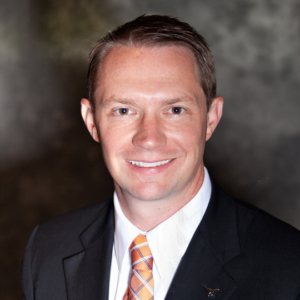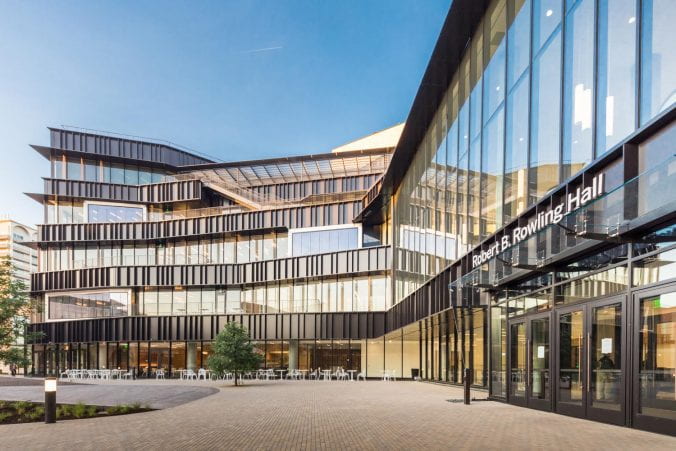
The Texas McCombs Class of 2023 Executive MBA cohort traveled to Denmark and Sweden last summer for its week-long global immersion. Courtesy photo
In the decade that she considered it, there was always a reason for Komal Patel to put off an MBA.
She had a demanding job in developing B2B and B2C products through engineering, business operations, quality and product management functions. She juggled international assignments, moving between three countries, and an extended family in India. She became the mother to twin daughters.

Komal Patel
The pandemic gave her lots of time to think about her career. She explored multiple online and hybrid MBA programs that suddenly materialized as schools across the world pivoted to the virtual space. That flexibility opened up any program in the U.S. for her.
Instead, she stayed close to home. She chose the in-person executive MBA program at University of Texas at Austin McCombs School of business.
“I strongly believe in the power of connections. It is hard to replace the power of in-person opportunities to engage, participate and connect with classmates, faculty, alumni and various institutes like Sustainability Institute or Venture Lab programs,” says Patel, a product management leader at Dell Technologies where she leads the Compute Management Software portfolio.
“It is important to have these connections and access last beyond the program. UT McCombs being in Austin was the most feasible option for me for near term and longer term ROI. As a working mom, it is simply not feasible for me to go to Chicago or the Bay Area every other week or engage in programs after graduation.”
‘NO ONE LEFT BEHIND’
There were other factors that set McCombs’ EMBA apart for Patel. First, its once-per-month format fits into her jam-packed schedule, giving her confidence that she could manage her work, family, and school without losing her sanity. McCombs’ EMBA also requires seven immersions – including three in Austin, three in the United States, and a week-long global immersion – which allowed Patel to make connections and deepen her understanding of business ecosystems outside Texas.
“The program has the backing of solid UT and McCombs alumni and faculty which creates a unique opportunity for learning. We are directly learning from the alumni industry experts who are leading businesses and ventures around the world via case studies, company visits, class projects, panels and networking events,” says Patel who will graduate from the program this summer.
“Another factor for me was diversity of experience, McCombs was unique in that regard compared to other top ranked schools where I noticed cohort concentration of pure tech, consulting or finance backgrounds.”
The experience and expertise of her classmates has motivated Patel to show up with her full potential. Her cohort comes from a wide range of industries from tech to healthcare to energy to media.
“I am constantly amazed by their achievements and ability to manage hard situations. There is like an unspoken promise between us – ‘No one will be left behind’ – and it is reflected in our behaviors in every way and form,” she tells Poets&Quants.
TEXAS MCCOMBS EMBA SPOTLIGHT
The McCombs program lasts 20 months and meets on campus once per month in Rowling Hall. Classes are Thursdays through Saturdays. It offers a cohort-based, executive curriculum that emphasizes leadership, strategy, and analytics.
It ranked 22th in Poets&Quants’ 2022 composite EMBA ranking, falling from No. 9 the year before. Our composite ranking is based on U.S. schools’ performance in the three major EMBA rankings – U.S. News & World Report, the Financial Times, and The Economist – and schools that don’t participate in all three are penalized by our methodology. McCombs ranked 17th in U.S. News in 2022, 26th in the Economist, and did not participate in the Financial Times’ ranking. (The Economist, which announced this summer that it was killing its MBA ranking because of withering criticism, did not release an EMBA ranking in 2022.)
This week, Poets&Quants For Execs is looking into the Texas McCombs executive MBA as part of our EMBA Spotlight series. We asked Joe Stephens, senior assistant dean and director for Working Professional & Executive MBA Programs, to tell us more.
Let’s start with a brief history of the McCombs EMBA.
The Texas McCombs EMBA launched as “Option II” in 1981 as an every other Friday/Saturday on-campus format. Around 1999, it became the “Executive MBA” program and the “Option II” moniker was dropped. Back then, the program was organized in 12 lock-step required courses, with two electives offered.
Our most recent update launched in August 2021. We now offer four electives and 18 required courses, within a once per month on-campus cadence. We go deeper in leadership and strategy, and broadened the curriculum in the areas of quantitative analysis, finance, and global business.
What are the differentiators to your program? What makes the McCombs EMBA unique in your region?

Joe Stephens, senior assistant dean and director for Working Professional & Executive MBA Programs at Texas McCombs
In addition to the once per month, in-person format, the seven domestic and global immersions and increased emphasis on executive leadership, our program is known for its collaborative, and tight-knit environment.
For taking place on a campus of over 50,000 students and over a half million Longhorn alumni, the Texas McCombs EMBA is and feels much more like a family. Our students stand alongside one another in weddings, attend baby showers, and help each other out when challenging personal situations arise. Amazingly, our students tell us they always get a response when reaching out to Texas alums near and far. People really love to pay it forward in Longhorn Nation.
What type of student are you targeting?
We want students who are team players, but can also step up and lead when the opportunity comes. We want students who dare to be real, authentic, and vulnerable with the people around them.
Demographically, they come from all over and all walks of life. In fact, over the past seven years, we’ve averaged well north of 30% (closer to 40%) first generation college graduates in the EMBA program. That’s a stat not many programs talk about – or perhaps even track. We’re really proud of all our EMBAs, and especially those who have excelled professionally and in the classroom without a lot of knowledge and perhaps support around attaining a college degree during their youth. It speaks to their grit and raw smarts.
What kind of trends are you seeing in demand, applications and enrollments? How did the pandemic affect these?
If we go back a few years, our application volumes were off a little. Perhaps it was due to a hot job market in Texas, or stronger competition of MBA programs both regionally and nationally, something else, and most likely a combination of all these.
We redesigned the program and saw immediate results. That very first class, the Class of ‘23 which is about to graduate, broke some records – most notably the percentage of students commuting from outside the Austin metro area (60%) and the percentage of women in the cohort (37%).
The pandemic was challenging in that we couldn’t connect physically with people like we had before, but we tried a lot of new things: Virtual information sessions, and even holographically-delivered dual mode classes. We learned a lot. So, our primary focus is connecting people and building relationships in-person, but supporting them virtually between the monthly class sessions. We do this through intentional programming when they’re on campus as well as faculty holding online touchpoints when the EMBAs are not here.
What are some important program milestones?
The program has seen both recent and long-term success in EMBA rankings – as we appear in the top 10 or top 20 nationally in at least five different publications. This is a testament to the quality of students, alumni, and faculty involved with this program.

Texas McCombs' Robert B. Rowling Hall, home of the schools MBA programs, opened in 2018. Courtesy photo
What are the opportunities/challenges for the EMBA – generally and specifically to you – that you see ahead?
The trendline for companies supporting their executive MBA candidates is going the wrong direction, or has anyway, for probably the past 10 to 15 years. This is a global challenge with all our competitors. I don’t think that’s going to change abruptly, but I am seeing some signs that it could reverse a little as companies work hard to retain their top talent right now. Just this semester, we’ve had a near record number of requests for employer letters that our students send to HR for reimbursement.
Also, at UT – and I know this is the case at a lot of schools – we have an extremely experienced, talented, and dare I say, world class faculty, many of whom are looking to retire in the nearer term. So that creates a lot of opportunities for us to hire new faculty with different ideas and new ways of doing things. It’s exciting and slightly scary as well. Institutional memory can be really important – from connecting with alumni to knowing how to navigate the greater University of Texas network. We need to be intentional about that transfer of talent and knowledge.
What EMBA trends are you watching? Are you discussing online versions or more hybrid opportunities?
I think programs are trying to figure out the right offering mix for virtual and in-person content and program delivery. People love the flexibility of online, but they still crave the relationships and the rich, organic conversations that come from being in the same physical space.
I think our industry is likely to see additional fragmentation within the EMBA market, and you’re going to see successful schools gravitate to what they’re best at. We’re great at delivering a world class and holistic MBA experience at a relative value against our global peers.
Any news coming down the pike?
We like what we’re seeing with the recent redesign, and I look forward to continuing to make incremental improvements based on faculty and student feedback. We have a fantastic team here, from admissions to student life and leadership to career management. I really can’t imagine the program being in better hands.
Anything else you’d like to add?
The typical Executive MBA prospective student spends about three years thinking about pursuing it. I’ve always compared pursuing education to planting trees. The best day to do it was yesterday. The second best is today. We can still control what happens today, so go for it.
DON’T MISS THESE STORIES IN OUR EMBA SPOTLIGHT SERIES:
- UW FOSTER’S PROGRAM BRINGS STUDENTS TO SEATTLE’S TECH MECCA
- EMORY GOIZUETA’S PURSUIT OF FLEXIBILITY
- TCU NEELEY’S PROMISE: ‘ROI STARTS MONDAY’
- AT UMN CARLSON, A NEW CURRICULUM & HYBRID OPTION
- HOW CORNELL JOHNSON’S PROGRAM IS UNIQUELY SUITED TO THE MOMENT
- THE BENEFITS OF RUTGERS' ACADEMIC-RUN EMBA POWERHOUSE
- THE TWO-TRACK PROGRAM IN THE HEART OF MUSIC CITY





Questions about this article? Email us or leave a comment below.